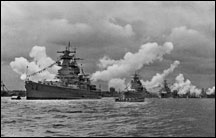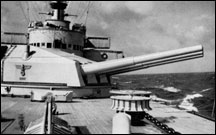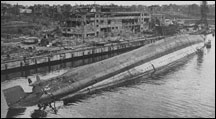Bismarck:
Bread,
Not Armored Cruisers!
By Mike Bennighof, Ph.D.
December 2019
 Following the First World War, the Versailles
Treaty limited German naval power to decidedly
third-rank status. The Weimar Republic was
left with eight pre-dreadnought battleships,
only six of which could be operational at
any one time. These could be replaced 20 years
after their launch, but any new ship would
be limited to 10,000 tons’ displacement. Following the First World War, the Versailles
Treaty limited German naval power to decidedly
third-rank status. The Weimar Republic was
left with eight pre-dreadnought battleships,
only six of which could be operational at
any one time. These could be replaced 20 years
after their launch, but any new ship would
be limited to 10,000 tons’ displacement.
The treaty placed no formal limit on armament,
but German leaders understood that the Allied
Powers would not tolerate anything greater
than 11-inch (280mm) or at best 12-inch (305mm
guns). The Allied naval experts consulted
during the treaty’s drafting process
assured the politicians that this would prevent
the Germans from building anything more capable
than coast defense ships like those operated
by the Swedish navy.

Admiral Scheer visits Gibraltar,
1936.
|
The oldest of the pre-dreadnoughts, Braunschweig, had been launched in December 1902. Planning
began for her replacement in 1920, but the initial
designs concentrated on reproducing the excellent
protection of the Imperial Navy’s dreadnoughts
on a very small hull, sacrificing both speed
and armament toward this goal.
When Admiral Hans Zenker took over the Reichsmarine
in 1924, he ordered a fresh set of designs.
Zenker had a new vision of the Navy’s
role in a future conflict. The admiral believed
France to be the most likely future opponent;
it would be impossible to build a battle fleet
to challenge the French alone, let alone the
British. Therefore Zenker sought to maximize
the possible: how could the Reichsmarine best
aid the German effort in a future war?
This turned military bureaucracy on its head;
the peacetime goal of any service is usually
the expansion of its funding and influence
at the expense of its nation’s other
services. Zenker abandoned hope of new battleships
and instead asked for long-range commerce
raiders that could damage French trade in
far-flung oceans, reducing French economic
strength directly and naval strength indirectly
by forcing the assignment of warships as convoy
escorts and to hunt for these raiders. The
ship should have enormous cruising range,
and at least one tactical advantage over potential
opponents.

Admiral Graf Spee leads Admiral
Scheer and Deutschland in
a peacetime naval parade.
|
At the high end of the plans, Zenker requested
a 17,500-ton “cruiser
killer” design. This ship would
only be possible if the Versailles restrictions
were eased, something that was not thought
likely. An example appears in our Great
War at Sea: U.S. Navy Plan Gold game.
The designers gave Zenker four variants of
what he considered politically feasible: a
10,000-ton armored ship with a speed of at
least 26 knots and an armament of six 280mm
guns. This would give her a gunnery advantage
against the “Washington Treaty cruisers”
then joining the American, British, French,
Japanese and Italian fleets, as they were
limited by treaty to 203mm (eight-inch) guns.
The new ship would also be faster than existing
battleships.
The Royal Navy and the Japanese Navy included
battle cruisers with both heavier guns and
greater speed than the new design, but Zenker
considered this an acceptable risk. His new
ship would at least have an edge over most
of her likely opponents.
The designs laid before the navy’s
chief included variants with 380mm (15-inch)
and 305mm (12-inch) guns. Though such ships
were not strictly forbidden, Zenker foresaw
enough domestic political trouble getting
the request approved and did not want to add foreign
pressure on top of it. The admiral chose a
design with its six heavy guns in two triple
turrets, another radical departure from Imperial
practice. German warships had always carried
their guns in double turrets, as this was
seen as offering better protection: a single
hit could at most knock out two guns, and
the turret armor could be thicker). The triple
turret saved weight and was thought to give
better gunnery results, since the fall of
shot would be more tightly grouped.

Deutschland’s forward gun
turret. Note the smaller bridge structure
compared to her sisters.
|
Defense Minister Wilhelm Groener considered
canceling the project outright, but eventually
asked the Reichstag to fund one such ship.
The outgoing Reichstag approved the request,
but it became the focal point of the 1928
elections with the Social Democratic Party
slate swearing to cancel the ship if elected
under the slogan “Bread, Not Armored
Cruisers!” The socialists won the highest
vote total and became the dominant party in
the new governing coalition, and soon found
themselves forced to renege on the promise
when their centrist coalition partners threatened
to bring down the government if the cruiser
were cancelled. The German shipbuilding industry
desperately wanted the work and the implied
renewal of German naval construction. The
Communists embarrassed the Socialists by launching
a petition drive to cancel the ship (an option
under the Weimar constitution) but failed
to gain enough signatures. Among the political
fallout, Zenker was forced to resign and Erich
Raeder became the new fleet commander.
The first ship, Deutschland, was laid
down at Deutsche Werke in Kiel in February
1929. She came in at 11,700 tons standard
displacement, having achieved great weight
savings through welded construction of her
hull (as opposed to the traditional rivets).
She also saved weight and achieved her endurance
of 10,000 nautical miles by carrying diesel engines
instead of turbines.
The Imperial Navy had experimented with diesels
for large warships, and in 1910 signed a contract
with MAN for a diesel engine to help power
the dreadnought Prinzregent Luitpold.
The battleship would have had coal- and oil-fired
boilers as well. Development problems slowed
the diesel’s deployment, and the battleship
was commissioned with her central engine room
empty and her center propeller shaft alley
welded shut. The engine was not ready for
sea until 1917, and would have been fitted
in the battleship Sachsen had she been
completed.
Deutschland showed that the extra
ten years hadn’t worked out all of the
kinks in the marine diesel. Breakdowns were
common, and she needed extensive yard work
during refits, much more than a conventionally-powered
ship. They did manage to exceed their design
speed, making 28 knots, but this would be
too slow to outrun the new fast battleships
that entered service in several navies by
1940.
Though called a “pocket battleship”
in the English-language naval press, this
term greatly exaggerated the ship’s
capabilities. She was about the same size
as a heavy cruiser and armored on the same
scale; the German Navy initially called them
“armored ships” and reclassified
the two surviving units as “heavy cruisers”
in early 1940.
The Great Depression and the Reichstag controversy
made it impossible to build a second ship
right away, and another (Admiral Scheer) was not authorized until 1931 with a third (Admiral Graf Spee) laid down in 1932.
When the Nazis came into power in late 1932,
Zenker’s vision of eight such ships
was replaced by a larger building program.
The two units projected for 1934 and 1935
were re-designed as the Scharnhorst class
battlecruisers, using some of the material
gathered for their construction. Raeder reverted
from Zenker’s radical views on ship
design to a more traditional German model,
emphasizing protection over armament but adopting
the new high-pressure steam turbines in place
of diesels.

Admiral Scheer, sunk by RAF bombers
9 April 1945 at Kiel, seen a month later.
|
The armored ships proved successful as commerce
raiders; Admiral Graf Spee sank only
nine ships before meeting her end off Montevideo,
Uruguay, but this had more to do with her
commander’s shattered nerves than a
design flaw. Deutschland (renamed Lützow in November 1939) was out of action for long
stretches with torpedo damage, but Admiral
Scheer conducted successful raids in the South
Atlantic and Indian Oceans.
Two of the class appear in Second
World War at Sea: Bismarck, and they
are present both for their own missions and
as optional units that could have been made
available for Bismarck’s fatal cruise
had German shipyards been able to refit them
more quickly.
Click
here to order Second World War at Sea:
Bismarck now!
Sign up for our newsletter right here. Your info will never be sold or transferred; we'll just use it to update you on new games and new offers.
Mike Bennighof is president of Avalanche Press and holds a doctorate in history from Emory University. A Fulbright Scholar and award-winning journalist, he has published over 100 books, games and articles on historical subjects.
He lives in Birmingham, Alabama with his wife, three children and his dog, Leopold.
|
